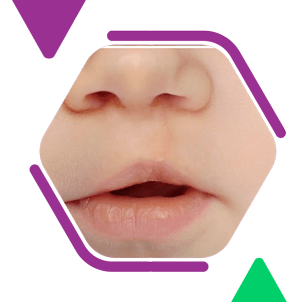- Home
- About Us
- Hair Treatment
- Hair Transplant
- Hair Loss
- Causes of Hair Loss
- Clinical Features
- Laboratory Test
- Medical Treatment
- Cyclic Treatment
- PRP
- Laser Treatment
- Surgical Treatment
- FUE
- Robotic
- FUT
- Beard Reconstruction
- Moustache Reconstruction
- Eyebrow Reconstruction
- Side Burn Reconstruction
- Complications Of Hair Transplant
- Alopecia Areata
- Telogen Effluvium
- Cosmetic Surgery
- Plastic Surgery
- Gallery
- Blogs
- Contact Us
Cleft Lip and Palate

Cleft Lip and Palate
Complex deformities involving the face and the skull lead to significant functional, aesthetic, and psychological problems. For cleft lip and palate, we offer treatment for:
- Facial bone deformities
- Skull deformities
- Deformities of the orbit, ear, and nose including conditions like Hemifacial macrosomia, Crouzon’s syndrome, Hypertelorism, etc.
Cleft lip and palate are among the most common congenital deformities affecting the face and skull, presenting significant functional, aesthetic, and psychological challenges. These conditions occur when the tissues that form the lip and palate do not fuse properly during fetal development, resulting in an opening or gap. The severity of cleft lip and palate can vary, ranging from a small notch in the lip to a large opening that extends into the nose and affects the palate.
Causes and Risk Factors
Cleft lip and palate are caused by development defect. Environmental factors such as maternal smoking, alcohol consumption, certain medications, and nutritional deficiencies during pregnancy can also contribute to the development of cleft lip and palate.
Associated Deformities and Syndromes
Cleft lip and palate are often associated with other craniofacial deformities and syndromes, which can further complicate treatment. Some of the associated conditions include:
– Facial Bone Deformities: These may include asymmetry of the jaw and midface, which can affect the alignment of the teeth and the overall facial structure.
– Skull Deformities: Conditions such as craniosynostosis, where the sutures in the skull close prematurely, can lead to abnormal skull shape and increased intracranial pressure.
– Deformities of the Orbit, Ear, and Nose: Conditions like Hemifacial microsomia, where one side of the face is underdeveloped, Crouzon’s syndrome, which involves premature fusion of skull bones leading to abnormal skull and facial growth, and Hypertelorism, characterized by abnormally wide-spaced eyes, can accompany cleft lip and palate.
Treatment Approaches
The treatment of cleft lip and palate requires a multidisciplinary approach involving surgeons, orthodontists, speech therapists, and other specialists. The primary goals are to restore function, improve appearance, and support the psychological well-being of the patient.
- Surgical Repair: The initial surgery to repair a cleft lip is typically performed within the first few months of life, while cleft palate repair is usually done before the child turns one and half year old. These surgeries aim to close the gaps in the lip and palate, restore normal function, and create a more typical facial appearance. Multiple surgeries may be needed as the child grows.
- Orthodontic Treatment: Orthodontists play a crucial role in managing dental and jaw alignment issues that often accompany cleft lip and palate. Braces, palate expanders, and other orthodontic devices are used to correct misaligned teeth and jaws, ensuring proper bite and function.
- Speech Therapy: Children with cleft palate often experience speech difficulties due to the gap in the palate affecting the movement of air through the mouth and nose. Speech therapists work with these children to develop proper speech patterns and improve communication skills.
- Psychological Support: The psychological impact of cleft lip and palate can be profound, affecting self-esteem and social interactions. Counselling and support groups can help children and their families cope with the emotional challenges and foster a positive self-image.
- Advanced Reconstructive Techniques: For severe deformities, advanced reconstructive techniques such as bone grafting, tissue expansion, and distraction osteogenesis (gradually lengthening bones) may be employed to achieve optimal outcomes. These procedures can help in reshaping the facial bones, correcting asymmetries, and improving overall facial harmony.
Challenges and Considerations
Treating cleft lip and palate presents numerous challenges. Timing of interventions is crucial to maximize outcomes and minimize complications. For instance, early surgeries aim to improve feeding and speech development, while later surgeries focus on refining appearance and function. Each patient’s treatment plan must be tailored to their unique needs, taking into consideration the severity of the deformities, associated conditions, and overall health.
Long-term follow-up is essential, as patients with cleft lip and palate may require multiple surgeries and ongoing care throughout their lives. Continuous monitoring and timely interventions can address emerging issues and ensure the best possible quality of life for these individuals.
Conclusion
Cleft lip and palate are complex congenital deformities that necessitate a comprehensive, multidisciplinary treatment approach. By addressing the functional, aesthetic, and psychological aspects of these conditions, healthcare providers can significantly improve the lives of affected individuals. Early intervention, ongoing care, and support are key to achieving successful outcomes and helping patients lead healthy, fulfilling lives.



 Book an Appointment
Book an Appointment